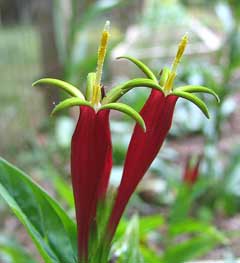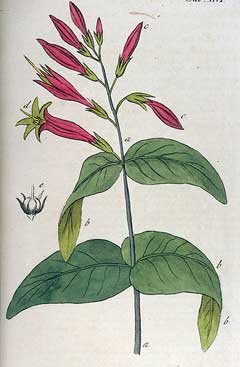 |
|
http://commons.wikimedia.org/wiki/User_talk:Phyzome |
 |
| http://commons.wikimedia.org/wiki/File:Spigelia_marilandica_Ypey56.jpg |
Translate this page:
Summary
Physical Characteristics

 Spigelia marilandica is a PERENNIAL growing to 0.5 m (1ft 8in) by 0.3 m (1ft).
Spigelia marilandica is a PERENNIAL growing to 0.5 m (1ft 8in) by 0.3 m (1ft).
See above for USDA hardiness. It is hardy to UK zone 8. It is in flower in July. The species is hermaphrodite (has both male and female organs).
Suitable for: light (sandy), medium (loamy) and heavy (clay) soils. Suitable pH: mildly acid, neutral and basic (mildly alkaline) soils. It can grow in semi-shade (light woodland) or no shade. It prefers dry or moist soil.
UK Hardiness Map
US Hardiness Map
Synonyms
Plant Habitats
Woodland Garden Sunny Edge; Dappled Shade; Shady Edge;
Edible Uses
References More on Edible Uses
Medicinal Uses
Plants For A Future can not take any responsibility for any adverse effects from the use of plants. Always seek advice from a professional before using a plant medicinally.
Anthelmintic Narcotic
The whole plant, but especially the root, is anthelmintic and narcotic[4, 21, 46]. A safe and effective anthelmintic when used in the proper dosage, it is especially effective with tapeworms and roundworm[4]. Its use should always be followed by a saline aperient such as magnesium sulphate otherwise unpleasant side effects will follow[4]. Another report says that it can be used with other herbs such as Foeniculum vulgare or Cassia senna[254]. These will ensure that the root is expelled along with the worms since the root is potentially toxic if it is absorbed through the gut[254]. The root is best used when fresh but can be harvested in the autumn then dried and stored[213]. It should not be stored for longer than 2 years[213]. Use with caution and only under professional supervision[21, 254]. The plant contains the alkaloid spigiline,which is largely responsible for the medicinal action but side effects of an overdose can include increased heart action, vertigo, convulsions and possibly death[222, 274].
References More on Medicinal Uses
The Bookshop: Edible Plant Books
Our Latest books on Perennial Plants For Food Forests and Permaculture Gardens in paperback or digital formats.

Edible Tropical Plants
Food Forest Plants for Hotter Conditions: 250+ Plants For Tropical Food Forests & Permaculture Gardens.
More

Edible Temperate Plants
Plants for Your Food Forest: 500 Plants for Temperate Food Forests & Permaculture Gardens.
More

More Books
PFAF have eight books available in paperback and digital formats. Browse the shop for more information.
Shop Now
Other Uses
References More on Other Uses
Cultivation details
Succeeds in most fertile soils in semi-shade[200]. Tolerates full sun if the soil remains reliably moist in the growing season[200], in a shady position it tolerates considerably drier soils[4]. Plants are hardy to about -15°c[200]. A very ornamental plant[1].
References Carbon Farming Information and Carbon Sequestration Information
Temperature Converter
Type a value in the Celsius field to convert the value to Fahrenheit:
Fahrenheit:
The PFAF Bookshop
Plants For A Future have a number of books available in paperback and digital form. Book titles include Edible Plants, Edible Perennials, Edible Trees,Edible Shrubs, Woodland Gardening, and Temperate Food Forest Plants. Our new book is Food Forest Plants For Hotter Conditions (Tropical and Sub-Tropical).
Shop Now
Plant Propagation
Seed - requires stratification, pre-chill for 3 weeks prior to sowing. It will usually germinate in 1 - 3 months at 20°c. Prick out the seedlings into individual pots once they are large enough to handle and grow on in a cold frame for their first winter. Plant out in late spring or early summer. Division in the spring. Basal cuttings in late spring. Harvest the shoots with plenty of underground stem when they are about 8 - 10cm above the ground. Pot them up into individual pots and keep them in light shade in a cold frame or greenhouse until they are rooting well. Plant them out in the summer.
Other Names
If available other names are mentioned here
Native Range
NORTHERN AMERICA: United States (Indiana, Missouri, Oklahoma, Alabama, Florida, Georgia, Kentucky, Louisiana, North Carolina, South Carolina, Virginia, Tennessee)
Weed Potential
Right plant wrong place. We are currently updating this section.
Please note that a plant may be invasive in one area but may not in your area so it's worth checking.
Conservation Status
IUCN Red List of Threatened Plants Status :

Growth: S = slow M = medium F = fast. Soil: L = light (sandy) M = medium H = heavy (clay). pH: A = acid N = neutral B = basic (alkaline). Shade: F = full shade S = semi-shade N = no shade. Moisture: D = dry M = Moist We = wet Wa = water.
Now available:
Food Forest Plants for Mediterranean Conditions
350+ Perennial Plants For Mediterranean and Drier Food Forests and Permaculture Gardens.
[Paperback and eBook]
This is the third in Plants For A Future's series of plant guides for food forests tailored to
specific climate zones. Following volumes on temperate and tropical ecosystems, this book focuses
on species suited to Mediterranean conditions—regions with hot, dry summers and cool, wet winters,
often facing the added challenge of climate change.
Read More
Expert comment
Author
L.
Botanical References
43200274
Links / References
For a list of references used on this page please go here
Readers comment
| Add a comment |
|
If you have important information about this plant that may help other users please add a comment or link below. Only comments or links that are felt to be directly relevant to a plant will be included. If you think a comment/link or information contained on this page is inaccurate or misleading we would welcome your feedback at [email protected]. If you have questions about a plant please use the Forum on this website as we do not have the resources to answer questions ourselves.
* Please note: the comments by website users are not necessarily those held by PFAF and may give misleading or inaccurate information.
To leave a comment please Register or login here All comments need to be approved so will not appear immediately.
|
Subject : Spigelia marilandica
|
|
|
|